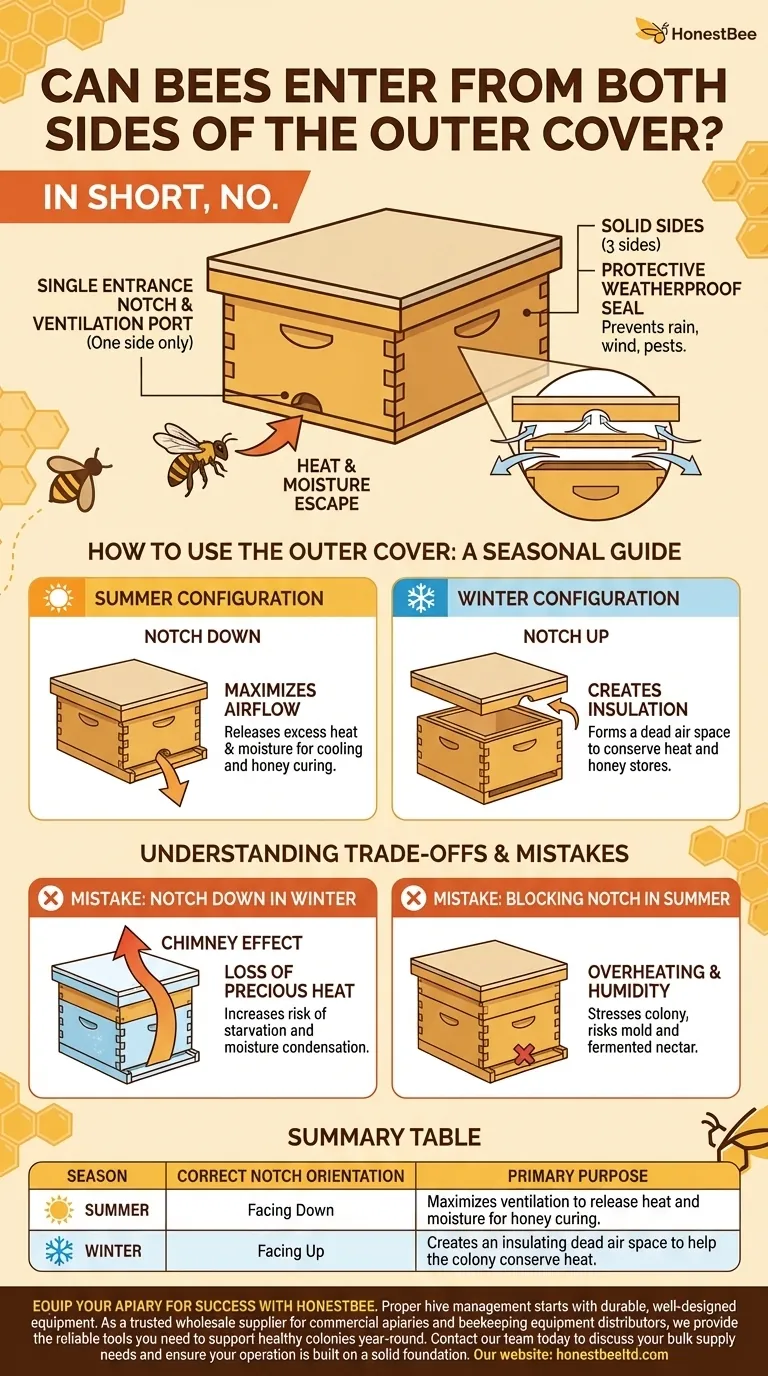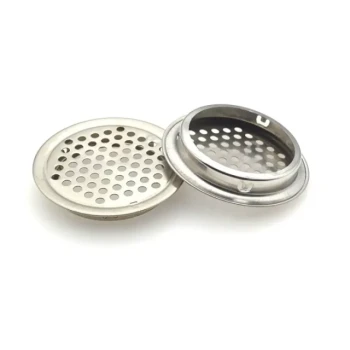In short, no. A standard Langstroth outer cover is intentionally designed with an entrance notch on only one of its long sides. Bees cannot enter from the opposite, solid side, which is designed to form a protective seal against the elements.
The single notch on an outer cover is not a manufacturing defect; it is a critical design feature. Its purpose is to give the beekeeper precise control over upper ventilation and access, which must be managed differently between summer and winter.

Understanding the Outer Cover's Design
To use your equipment effectively, you must understand the purpose behind its design. The outer cover and inner cover work together as a system to control the hive's internal environment.
The Purpose of the Notch
The small, semi-circular notch serves two primary functions. First, it acts as an upper entrance and exit for the bees. More importantly, it is a ventilation port that allows hot, moist air to escape the hive.
Bees constantly regulate the hive's temperature and humidity. The notch provides an essential release valve, preventing condensation from building up and raining down on the colony, especially during honey curing.
The Solid (Non-Notched) Side
The three solid sides of the outer cover are equally important. When the cover is seated, these sides "telescope" down over the top hive body, creating a weatherproof seal.
This design protects the colony from rain, wind, and pests that might try to invade from the top of the hive.
How to Use the Outer Cover: A Seasonal Guide
The correct orientation of the outer cover's notch is dependent on the season and your specific goals for the colony.
Summer Configuration: Notch Down
During the warm months of the main nectar flow, you should place the outer cover on the hive with the notch facing down.
This aligns the outer cover's notch with the central opening in the inner cover below it. This configuration maximizes airflow, releasing excess heat and moisture, which helps the bees cool the hive and efficiently cure nectar into honey.
Winter Configuration: Notch Up
In preparation for cold weather, the orientation is reversed. You should place the outer cover on the hive with the notch facing up, away from the inner cover.
This allows the inner cover to create a sealed "ceiling" over the hive. The space between the inner and outer cover becomes a layer of dead air, providing crucial insulation that helps the colony conserve heat and honey stores throughout the winter.
Understanding the Trade-offs and Common Mistakes
Improperly orienting the outer cover can have significant consequences for the health of your colony. Understanding the trade-offs is key to successful beekeeping.
Mistake: Leaving the Notch Down in Winter
This is a common and critical error for new beekeepers. Creating an upper vent in winter produces a "chimney effect," constantly drawing precious heat out of the hive.
The bee cluster must burn through significantly more honey to stay warm, increasing the risk of starvation. It also increases the likelihood of moisture condensing and freezing inside the hive.
Mistake: Blocking the Notch in Summer
If you were to orient the notch up or block it during the summer, you would severely restrict ventilation. The hive could overheat, stressing the colony.
This lack of airflow also traps humid air inside, making it harder for bees to cure honey and potentially leading to mold or fermented nectar.
Making the Right Choice for Your Hive
Your decision on how to orient the cover directly impacts the colony's ability to manage its environment.
- If your primary focus is keeping the colony cool and curing honey in summer: Place the outer cover with the notch facing down to maximize ventilation.
- If your primary focus is helping the colony conserve heat in winter: Place the outer cover with the notch facing up to create an insulating dead air space.
- If your primary focus is protecting the hive from rain and pests: Ensure the outer cover is always seated properly, telescoping over the hive body to create a tight seal.
Understanding this simple design feature empowers you to actively manage your hive's environment for year-round success.
Summary Table:
| Season | Correct Notch Orientation | Primary Purpose |
|---|---|---|
| Summer | Facing Down | Maximizes ventilation to release heat and moisture for honey curing. |
| Winter | Facing Up | Creates an insulating dead air space to help the colony conserve heat. |
Equip your apiary for success with HONESTBEE. Proper hive management starts with durable, well-designed equipment. As a trusted wholesale supplier for commercial apiaries and beekeeping equipment distributors, we provide the reliable tools you need to support healthy colonies year-round. Contact our team today to discuss your bulk supply needs and ensure your operation is built on a solid foundation.
Visual Guide

Related Products
- Telescopic Beehive Outer Cover Lid Roof with Galvanised Sheeting for Langstroth Hive and Beehive Outer Cover
- Long Langstroth Style Horizontal Top Bar Hive for Wholesale
- Professional Insulated Winter Hive Wrap for Beekeeping
- Stainless Steel Round Beehive Air Vents for Ventilation
- Professional Drop-Style Hive Handles for Beekeeping
People Also Ask
- What is a telescoping outer cover and what are its advantages? Maximize Hive Protection in Harsh Climates
- What is the function of the top cover in a Langstroth hive? Master Hive Protection & Climate Control
- What is the purpose of a garden hive lid in beekeeping? Essential Protection for Your Colony's Health
- What are the two primary lid styles for Langstroth style beehives? Choose the Right Protection for Your Hives
- What maintenance is recommended for the Langstroth hive roof? Protect Your Hive with Natural Tung Oil



















